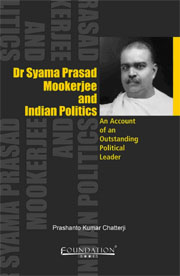Book contents
- Frontmatter
- Contents
- Preface
- 1 Dr Syama Prasad Mookerjee as the Finance Minister of Bengal, 1941–1942
- 2 Syama Prasad and Hindu Mahasabha's Ascendancy in Indian Politics, 1938–1944
- 3 Syama Prasad and Hindu Mahasabha's Transitory Resuscitation after Reverses, 1945–1947
- 4 Syama Prasad's Achievements as the Central Cabinet Minister, 1947–1950
- 5 Syama Prasad and Establishment of Bharatiya Jana Sangh, 1950–1953
- 6 Conclusion
- Appendix I
- Appendix II
- Appendix III
- Appendix IV
- Appendix V
- Appendix VI
- Appendix VII
- Bibliography
- Index
2 - Syama Prasad and Hindu Mahasabha's Ascendancy in Indian Politics, 1938–1944
Published online by Cambridge University Press: 05 February 2012
- Frontmatter
- Contents
- Preface
- 1 Dr Syama Prasad Mookerjee as the Finance Minister of Bengal, 1941–1942
- 2 Syama Prasad and Hindu Mahasabha's Ascendancy in Indian Politics, 1938–1944
- 3 Syama Prasad and Hindu Mahasabha's Transitory Resuscitation after Reverses, 1945–1947
- 4 Syama Prasad's Achievements as the Central Cabinet Minister, 1947–1950
- 5 Syama Prasad and Establishment of Bharatiya Jana Sangh, 1950–1953
- 6 Conclusion
- Appendix I
- Appendix II
- Appendix III
- Appendix IV
- Appendix V
- Appendix VI
- Appendix VII
- Bibliography
- Index
Summary
SECTION-1: Growth of Hindu Mahasabha and Its Emergence as an All-India Force, 1938–1941
After the 1937 elections, the Congress swept the polls with respect to the Hindu seats. The Muslim League did not cut much ice in Bengal, as elsewhere, and Fazlul Haq's Krishak Praja Party came to the Bengal Legislature with a fairly large representation, with Haq defeating Nazimuddin at Patuakhali; and “it looked as if the reactionary Muslim elements had received a death blow”. If the Congress had responded to Haq's entreaty to form a coalition ministry in Bengal with himself as Premier, Bengal “would have developed into a strong and healthy province with the common efforts of representative Hindus and Muslims”. But as Dr Mookerjee says, “Congress policy regarding acceptance of office was still uncertain. Sarat Bose himself was even then deluding himself with such a declaration, ‘The Congress has come to the Legislature to end the Constitution and not to work it.’… It (Congress) was not prepared to co-operate or form a coalition with anyone. It must rule as a single party.” So the Congress High Command did not allow the Bengal Congress to join with Fazlul Haq's party, thus throwing Bengal “at the mercy of British-cum-League domination”. Accordingly, Haq joined the League in forming a ministry on 1 April 1937, headed by himself. He inducted N.R. Sarkar, B.P. Singh Roy and Maharaja of Cossimbazar as the Caste Hindu ministers.
- Type
- Chapter
- Information
- Dr Syama Prasad Mookerjee and Indian PoliticsAn Account of an Outstanding Political Leader, pp. 70 - 148Publisher: Foundation BooksPrint publication year: 2010

